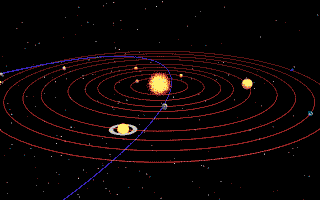

 Johannes
Kepler (1571-1630) published his work Harmonices Mundi, in
1619. This work, in which he attempted to explain the harmony of the
world, was a series of five books and contained what is known today
as his third law. The work was founded on geometry, from which Kepler
derived first a theory of musical harmony and then a cosmology of
the heavens and the earth.
Johannes
Kepler (1571-1630) published his work Harmonices Mundi, in
1619. This work, in which he attempted to explain the harmony of the
world, was a series of five books and contained what is known today
as his third law. The work was founded on geometry, from which Kepler
derived first a theory of musical harmony and then a cosmology of
the heavens and the earth.
Kepler was attempting to find common rules between music and movement in the solar system. His music of the spheres is based on the relative maximum and minimum angular velocities of the planet measured from the sun. Using his theories, Kepler allotted to the planets musical intervals and musical motion.
Kepler describes these ideas in Harmonice Munde as his attempt "to erect the magnificent edifice of the harmonic system of the musical scale . . . as God, the Creator Himself, has expressed it in harmonizing the heavenly motions."

There is a major complication for anyone who would attempt to perform Kepler's Music of the Spheres in real time: using Kepler's formulas it would take 30 years to perform the entire piece. So, to even attempt to recreate Kepler's cosmic music, it is possible to compress the time factor for the music, and then we can listen to a representation of this harmony of planetary motion.
The following music notation and MP3 samples are of course simply an attempt to recreate Kepler's mathematic formulas of the music of the spheres in real time. Kepler himself stated that, "I grant you that no sounds are given forth, but I affirm . . . that the movements of the planets are modulated according to harmonic proportions.". This music is an arranged representation of those proportions.

The Music Of The Spheres We have prepared a PDF file of the Music of the Spheres and the music of the Earth and Moon, in standard music notation that you can use to experiment with the planetary harmonies. You can download the music notation and The MP3s include examples of various combinations of the 6 planets in Keplers's math of harmonic motion, all planets together, and also an MP3 of each separate planet and the moon. Listen a few examples of the MP3 samples: Mercury, Venus & Earth - MP3 Jupiter & Saturn - MP3 Music of the spheres planetary harmony - MP3 Earth & Moon - MP3
Music Of The Spheres
All Music - Copyright 2019 - All Rights Reserved |

